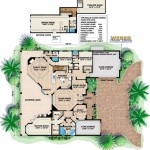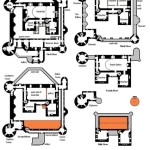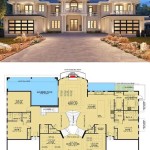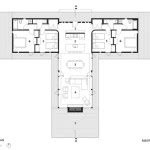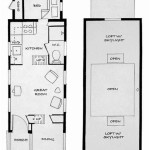A “4 Room House Plan” is a blueprint for the construction of a house that typically includes four separate rooms. These rooms are usually designed to serve specific functions, such as bedrooms, bathrooms, a kitchen, and a living room. The specific layout and dimensions of each room may vary depending on the individual design of the house and the intended use of the space.
4 Room House Plans are commonly used in the design of small to medium-sized homes and are suitable for a variety of purposes. They are often employed in the construction of single-family homes, vacation homes, and rental properties. The compact size and efficient use of space make them a popular choice for those looking to build a home that is both functional and cost-effective.
In the following sections, we will explore the advantages and disadvantages of 4 Room House Plans, provide examples of different design options, and offer tips on how to create a 4 Room House Plan that meets your specific needs.
4 Room House Plans offer numerous advantages, but also have some limitations to consider.
- Compact and efficient
- Suitable for small families
- Cost-effective to build
- Versatile design options
- Limited space for additional rooms
- May not be suitable for large families
- Can feel cramped if not well-designed
- Important to plan for adequate storage
- Consider future needs when designing
Overall, 4 Room House Plans can be a great option for those looking to build a small, functional, and affordable home. However, it’s important to carefully consider your specific needs and lifestyle before making a decision.
Compact and efficient
One of the main advantages of 4 Room House Plans is their compact and efficient design. These plans make the most of available space, ensuring that every square foot is used wisely. This can be especially beneficial for those who are looking to build a home on a smaller lot or who have a limited budget.
- Reduced construction costs: Smaller homes require less materials and labor to build, which can lead to significant savings on construction costs.
- Lower energy bills: Smaller homes are more energy-efficient to heat and cool, resulting in lower utility bills.
- Easier to maintain: Smaller homes are easier to clean and maintain, freeing up more time for other activities.
- Less wasted space: 4 Room House Plans are designed to minimize wasted space, ensuring that every room serves a specific purpose.
Overall, the compact and efficient design of 4 Room House Plans makes them a great option for those looking to build a home that is both affordable and functional.
Suitable for small families
4 Room House Plans are well-suited for small families, typically consisting of a couple with one or two children. The compact size of these homes provides enough space for each family member to have their own private room, while the open and efficient layout promotes family interaction and togetherness.
- Adequate bedrooms and bathrooms: 4 Room House Plans typically include two to three bedrooms and one to two bathrooms, providing ample space for a small family.
- Functional living areas: The living room and kitchen are often combined into one open space, creating a cozy and inviting area for family activities and entertaining guests.
- Private outdoor space: Many 4 Room House Plans include a small backyard or patio, providing a private outdoor space for relaxation and play.
- Affordable and easy to maintain: 4 Room House Plans are relatively affordable to build and maintain, making them a great option for families on a budget.
Overall, 4 Room House Plans offer a comfortable and functional living environment for small families, providing adequate space, privacy, and affordability.
Cost-effective to build
One of the primary advantages of 4 Room House Plans is their cost-effectiveness. These plans are designed to minimize construction costs without sacrificing functionality or comfort.
Smaller size: The compact size of 4 Room House Plans means that they require less materials and labor to build compared to larger homes. This can result in significant savings on construction costs.
Simple design: 4 Room House Plans typically feature simple and straightforward designs, reducing the need for complex and expensive construction techniques.
Energy efficiency: The compact size and efficient design of 4 Room House Plans make them more energy-efficient to heat and cool, leading to lower utility bills over the long term.
Reduced maintenance costs: Smaller homes are generally easier and less expensive to maintain compared to larger homes, saving homeowners money in the long run.
Overall, the cost-effectiveness of 4 Room House Plans makes them a great option for those looking to build a home that is both affordable and functional.
Versatile design options
4 Room House Plans offer a wide range of versatile design options, allowing homeowners to customize their homes to suit their specific needs and preferences.
Open floor plans: Many 4 Room House Plans feature open floor plans, which combine the living room, dining room, and kitchen into one large, open space. This design creates a sense of spaciousness and promotes natural light flow, making the home feel larger and more inviting.
Flexible room configurations: The rooms in a 4 Room House Plan can be configured in a variety of ways to accommodate different family dynamics and lifestyles. For example, one room can be designated as a bedroom, while another can serve as a home office or playroom.
Customizable exteriors: The exterior of a 4 Room House Plan can be customized to reflect the homeowner’s personal style and preferences. This includes choosing different siding materials, window styles, and roof designs.
Overall, the versatile design options available with 4 Room House Plans make it easy for homeowners to create a home that is both functional and stylish.
Limited space for additional rooms
One potential limitation of 4 Room House Plans is the limited space available for additional rooms. With only four rooms, it may be challenging to accommodate all of the desired functions and spaces in the home.
For example, if a family needs a dedicated home office or a guest room, they may need to consider expanding the house or reconfiguring the existing layout. This can add to the cost and complexity of the construction process.
Another challenge is the lack of flexibility in expanding the home in the future. If the family’s needs change and they require more space, it may be difficult to add on to a 4 Room House Plan without significantly altering the original design.
However, it’s important to note that 4 Room House Plans can be designed with clever space-saving solutions, such as built-in storage and multi-purpose rooms. Careful planning and utilization of available space can help to mitigate the limitations of having only four rooms.
Overall, while 4 Room House Plans offer numerous advantages, it’s essential to carefully consider the potential limitations and ensure that the design meets the specific needs of the homeowners.
May not be suitable for large families
4 Room House Plans may not be suitable for large families due to the limited number of rooms and the overall size of the home. With only four rooms, it can be challenging to accommodate the needs of a family with multiple children, elderly parents, or frequent guests.
For example, a family with three or more children may require at least three bedrooms, leaving only one room for other purposes such as a living room, dining room, or home office. This can lead to space constraints and a lack of privacy for individual family members.
Additionally, the overall size of a 4 Room House Plan may be too small for a large family. These homes typically range from 1,000 to 1,500 square feet, which may not provide enough space for comfortable living and storage.
Families with specific needs, such as dedicated home offices, playrooms, or guest rooms, may also find 4 Room House Plans to be limiting. Expanding or reconfiguring the home to accommodate these additional spaces can be costly and may compromise the original design.
Therefore, while 4 Room House Plans can be a great option for small families or couples, they may not be suitable for large families who require more space, privacy, and flexibility in their living arrangements.
Can feel cramped if not well-designed
4 Room House Plans can feel cramped and uncomfortable if they are not well-designed. Careful planning and attention to detail are crucial to ensure that the home feels spacious and inviting, even with a limited number of rooms.
- Poor space utilization: Inefficient use of space can lead to a cramped feeling. Avoid unnecessary hallways, wasted corners, and awkward room shapes. Use built-in storage solutions, multi-purpose furniture, and clever design tricks to maximize space utilization.
- Lack of natural light: Dark and gloomy spaces can make a home feel smaller and more confining. Incorporate plenty of windows and skylights to bring in natural light and create a more spacious and airy atmosphere.
- Overcrowding: Trying to fit too much furniture and belongings into a small space can quickly lead to a cluttered and cramped environment. Choose furniture that is appropriately sized for the space and avoid excessive decorations or collections.
- Poor ventilation: Proper ventilation is essential for maintaining good air quality and preventing stuffiness. Ensure that the home has adequate windows, vents, and fans to promote airflow and create a more comfortable living environment.
By carefully considering these factors and implementing thoughtful design solutions, homeowners can create a 4 Room House Plan that feels spacious, comfortable, and inviting, despite its compact size.
Important to plan for adequate storage
Adequate storage is crucial in any home, but it becomes even more important in a 4 Room House Plan due to the limited space. Careful planning and implementation of storage solutions can help to keep the home organized, clutter-free, and functional.
- Maximize vertical space: Utilize vertical space by installing shelves, cabinets, and drawers that go up to the ceiling. This is especially useful in small spaces where floor space is limited.
- Use multi-purpose furniture: Choose furniture pieces that serve multiple purposes, such as ottomans with built-in storage or beds with drawers underneath. This helps to save space and keep belongings organized.
- Incorporate built-in storage: Built-in storage solutions, such as closets, shelves, and cabinets, can be customized to fit specific spaces and needs. They provide a seamless and space-saving way to store items.
- Utilize unused areas: Look for unused areas in the home, such as under stairs or in awkward corners, and convert them into storage spaces. This helps to maximize every available inch of space.
By incorporating these storage solutions into the design of a 4 Room House Plan, homeowners can ensure that their home remains organized, clutter-free, and comfortable, despite its compact size.
Consider future needs when designing
When designing a 4 Room House Plan, it is crucial to consider future needs and potential changes in lifestyle. This foresight can help homeowners create a home that not only meets their current requirements but also adapts to their evolving needs over time.
For example, if a couple is planning to start a family in the future, they may want to consider a 4 Room House Plan that includes an additional bedroom or a flexible space that can be converted into a nursery. Similarly, if homeowners anticipate hosting frequent guests or aging parents, they may want to incorporate a guest room or a dedicated space for assisted living.
Another important aspect to consider is accessibility. If there is a possibility of future mobility limitations, it is wise to design the home with wider doorways, ramps, and accessible bathrooms. This can ensure that the home remains comfortable and functional for all occupants, regardless of their age or physical abilities.
Additionally, homeowners may want to consider future changes in their work or lifestyle that could impact their space requirements. For example, if they anticipate working from home in the future, they may want to incorporate a dedicated home office into the design. Similarly, if they enjoy hobbies or activities that require specialized spaces, such as a workshop or a music room, it is important to plan for these needs from the outset.
By considering future needs and potential life changes when designing a 4 Room House Plan, homeowners can create a home that is not only functional and comfortable in the present but also adaptable and responsive to their evolving needs in the years to come.
It is also worth noting that making significant structural changes to a home after it has been built can be costly and disruptive. Therefore, it is advisable to plan for future needs as much as possible during the design phase to avoid the need for major renovations or additions in the future.
Ultimately, by carefully considering future needs and incorporating flexibility into the design, homeowners can create a 4 Room House Plan that not only meets their current requirements but also provides a solid foundation for a comfortable and adaptable living environment for years to come.







![Modern Four Bedroom House plan Design [January ]](https://i3.wp.com/dconsult.com/wp-content/uploads/2019/05/1219-B-19-RENDER-02.jpg)


Related Posts

